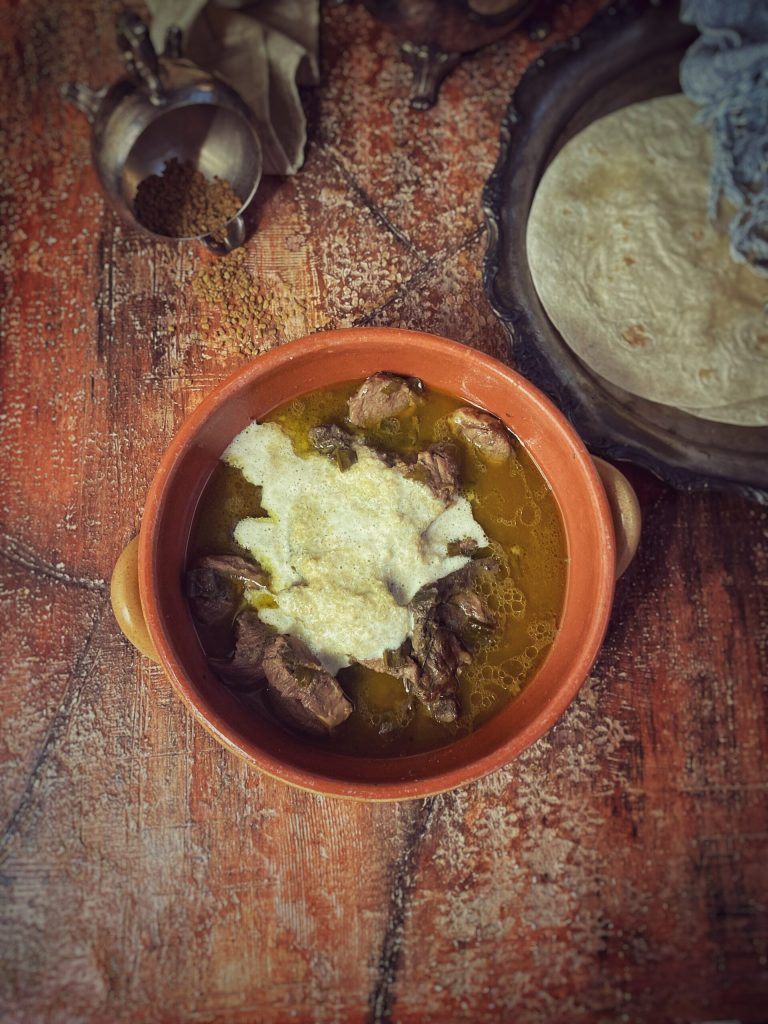Hulbah and Fahsa are the Yemeni sauce and dish that conclude the Sauce Menu for the column “Building the Menu”.
Hulbah, holbah, helbeh, or hilbeh (Arabic: حلبة) is a seasoning made from ground fenugreek seeds.
A traditional Yemeni food popularized especially by Yemeni Jews in Israel, who introduced it to other ethnic groups.
The fenugreek seeds are soaked in water for a few hours and then blended, taking on a light and foamy consistency.
It can be eaten alone or added to saltah and fahsa.
Fahsa (Arabic: فحسة) is widely consumed in the northern parts of the country.
In the Ottoman Empire, it was used as a charity food and prepared with leftover food donated by the rich or mosques.
It is a meat stew, usually lamb, cooked in maraq (lamb broth), and seasoned with a spoonful of hulbah and sometimes with sahawiq (a mixture of chilies, tomatoes, garlic, and ground herbs).
It is traditionally eaten with khubz mulawah, a Yemeni flatbread similar to Indian paratha and is traditionally cooked in a hardened clay pot known as haradah or maguao.
Fahsa is an ancient Yemeni dish that some say is thousands of years old. It is said that its ingredients once were only maraq and hulbah, since then it has split into two dishes: fahsah and saltah.
Both dishes are sometimes referred to interchangeably as saltah-fahsa or fahsa-saltah, but the difference lies in the ingredients, as fahsa is prepared only with meat while saltah also contains vegetables, and sometimes only those.

- Difficulty: Easy
- Cost: Affordable
- Rest time: 3 Hours
- Preparation time: 15 Minutes
- Cooking methods: Boiling
- Cuisine: Arab
- Seasonality: All seasons
Ingredients for hulbah and fahsa:
- 2 teaspoons fenugreek seeds
- 4 tablespoons water
- 4.4 lbs lamb (preferably chops)
- 1 onion
- 3 cloves garlic
- 5 cups maraq* (lamb broth)
- to taste cumin
- to taste olive oil
- to taste salt
Tools
- 1 Immersion Blender
- 1 Clay Pot
Steps
Soak the fenugreek seeds in water for 3 hours.
Drain and blend with an immersion blender with 3 tablespoons of water.

In a pot – preferably made of clay – add a drizzle of oil, the chopped onion, garlic. Sauté the boneless meat, meaning without any bones, for 10 minutes.
Add salt and cumin.
Cover with the lamb broth (maraq).
Note: I prepared the broth with the bones of the lamb chops, cooking them for 1 hour in 5 cups of water along with onion and spices.
Cook for 2 hours.

FAQ
*How to prepare maraq?
Maraq is a dish in its own right.
The word itself simply means “broth” in Arabic. It originated in Yemen but is also found in Somalia, Oman, and Indonesia.
It can be consumed on its own or serve as the broth base for fahsa.
However, fahsa can also be prepared without meat broth, using water instead.
In general, more meat is added to one’s fahsa beyond what is in the maraq.
The cooking process of maraq usually starts by boiling meat with some spices and onions. Once the meat is tender and cooked, it is served on a bed of rice.
The broth is served in a separate bowl. It is also common to squeeze fresh lime into the
maraq as it cools to add flavor.What is fenugreek?
Fenugreek (Trigonella foenum-graecum) is a plant that grows spontaneously in coastal and sub-mountainous environments.
Likely originating from western Asia, it has a peculiar smell, repugnant to some, pleasant and characteristic to others.
The term fenugreek refers to the use of the plant in livestock feed.
In Arab countries, it is traditional to enrich dishes intended for engaged girls with its seeds, to soften body shapes and make them more desirable in the eyes of the husband.
In India, fenugreek is used in masala, while in America, the oil derived from the seeds is used in baked goods and ice creams.
Fenugreek seed extract has restorative and stimulating properties, making it suitable for malnutrition, anemia, childhood frailty, convalescence, and breastfeeding.

